The Mao Asada Thanks Tour, Nagano show
April 16, 2020
By Atsuko Kuryu
Photos © Keiko Kasai
Mao Asada was at a loss after her retirement; wondering what she should do. But at last she found her way, a Thanks Tour! She looked at this tour as the culmination of her skating life.
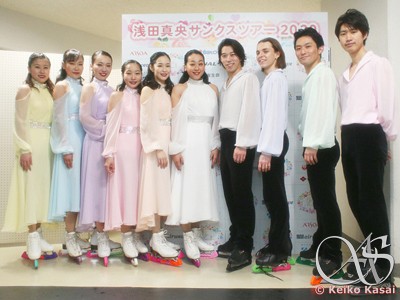 The tour started in May 2018 at the Niigata Asahi Alex ice arena, which is a local and small ice rink. Mao decided to use local ice rinks for several reasons: the set-up time is short, where it usually takes five days and at a huge cost to set up an ice rink in a big venue. She wanted as many people as possible to be able to come and enjoy her show, not just core fans. And she tried to set ticket prices at an affordable level. She prepared some tickets which are available for pre-sale only in the local area where the show takes place, making it easier for people in that area to get them. So far she has completed well over 150 shows in Japan, and will continue for another year before ending the tour.
The tour started in May 2018 at the Niigata Asahi Alex ice arena, which is a local and small ice rink. Mao decided to use local ice rinks for several reasons: the set-up time is short, where it usually takes five days and at a huge cost to set up an ice rink in a big venue. She wanted as many people as possible to be able to come and enjoy her show, not just core fans. And she tried to set ticket prices at an affordable level. She prepared some tickets which are available for pre-sale only in the local area where the show takes place, making it easier for people in that area to get them. So far she has completed well over 150 shows in Japan, and will continue for another year before ending the tour.
Keiko and I were delighted to have the chance to cover her Thanks Tour in Nagano and report about it.
Mao had given over 110 shows before this one, but it was my first time to watch it. It was a remarkable experience, and very different from all other shows I've attended. There was 80 minutes of non-stop show, and from the very beginning we were drawn into Mao's world of skating. It presented Mao's programs from her skating career, a stroll down memory lane, well, at least in a way. There are similarities you will recognize for sure, but also differences. The programs are now brought into new light with updated choreography, rearranged music and a fantastic show atmosphere.
Some programs were skated by Mao herself, and some by other skaters, such as Takahito Mura and Haruka Imai. But regardless, each program reflected the essence of Mao and what she wanted with this tour. The skaters talked through the video during the show and expressed their feelings about how they began to recognize gratitude for lots of thing or people through the way Mao created the spirit of this show. And you could see it through their performances.
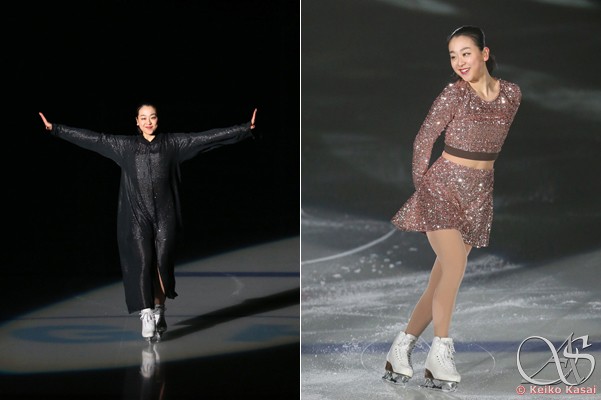
In the beginning, Mao appeared on the ice wearing a black cloak covering her whole body and hiding her face under a hood. Upon taking it off, a glittering, glamorous costume was revealed. It was said the black cloak symbolizes how she felt after her retirement from eligible skating until she found her way to this show, and the bright costume shows her delight in finding that way. Then, other skaters wearing sparkling costumes like Mao's, entered one after another. Mao said she wanted all the cast members to shine to the lyrics of the opening music (This Little Light of Mine/ Smile/ What a Wonderful World). All the skaters were well prepared and enjoyable to have around. Mao had conducted the auditions of her co-skaters herself; some we knew well through national competitions while others were unfamiliar.
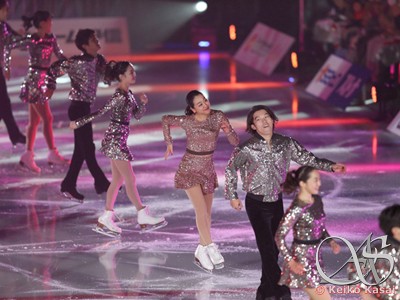 Let me give you a short review: during the opening number, Mao called the name of each cast members, as if introducing her friends at a joyful party. They skated their own parts and fully displayed their talent and personality, and certainly raised our expectations for the rest of the show.
Let me give you a short review: during the opening number, Mao called the name of each cast members, as if introducing her friends at a joyful party. They skated their own parts and fully displayed their talent and personality, and certainly raised our expectations for the rest of the show.
The first solo program So Deep Is The Night was skated by Haruka Imai. She was pure and lovely and skated so fast and smooth that you couldn't believe she retired two years ago. She followed the music so well and looked very elegant. Sei Kawahara, who used to be an elite skater and competed in many international events, came in next to Nocturne by Chopin. I regretted not noticing what a graceful skater he is while he still competed. Had I known, I would have cheered him on louder at competitions. But when watching a competition you are more likely to be affected by the results than by the skaters' performance itself. Anyway, he was fantastic and I enjoyed his part very much. Later in this program Sei was joined by Takahito, who skated with both power and grace. In Putting On The Ritz, Mao and Seiya Hashimoto danced rhythmically to the music, and made the audience feel like they wanted to dance too. After quickly changing her clothes, Mao started on Bei Mir Bistu Shein where she played a coquettish woman who lead four men by the nose. She was very cute; however the male skaters (Takahito, Sei, Ernesto Martinez, Seiya) were just as attractive, if not better. Finally, Mao chose one of the four men, but her choice seemed to change from show to show.
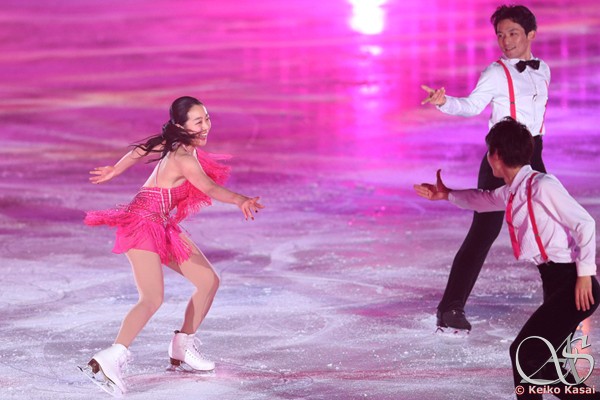
After this upbeat and fun piece was over, the chic and romantic performance of the ladies began to Suite Bergamasque by Debussy. They skated while holding white spherical lights, and each looked like a fairy dancing on the moon. When the music changed into Over The Rainbow, they waived long, rainbow colored ribbons, which was no easy thing to do. The ladies skating were Nagisa Hayashi, Gunsukh Maral Erdene, Mari Yamamoto, Risa Kouch, and Haruka: all of them very beautiful.
Mao skated Bach's Suite for Violoncello solo, next. It was a very beautiful and artistic program which felt like watching a ballet stage. Mao moved very fast and without any stops, and repeated some movements quickly; her pivot was beautiful; the spins were fast and brilliant. I couldn't find words to explain but it was all different! In contrast, Por Una Cabeza was a very entertaining program, and you might take that for granted since it was an exhibition piece from the beginning, however, it was a lot more than that. Unfortunately, without enough time to fully enjoy this piece, the music turned into Masquerade with all the skaters except Mao and Haruka dancing on the ice, and the rink seemed to change into a ball room. The movement of the skaters was so fast you couldn't tell who was who, and all were equally gorgeous. 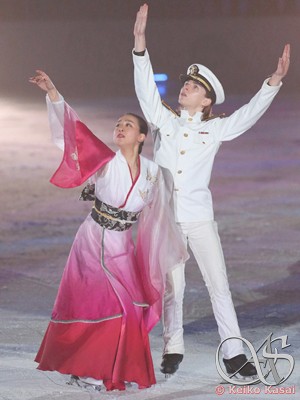 Then Mao beautifully skated her Madame Butterfly program wearing a long red
and white kimono with a black belt and trim around the neckline. She moved very dynamically and beautifully and the long hanging sleeves and skirt made dramatic sweeping motions to represent Madame Butterfly's grief and loss.
Then Mao beautifully skated her Madame Butterfly program wearing a long red
and white kimono with a black belt and trim around the neckline. She moved very dynamically and beautifully and the long hanging sleeves and skirt made dramatic sweeping motions to represent Madame Butterfly's grief and loss.
I remember Mao's free program at the 2010 Olympic Games in Vancouver, Prelude in C-sharp minor by Rachmaninov. There was some controversy when she chose it for her free program in the Olympic season, as some thought it might be too dark or too difficult for figure skating. Mao, however, did turn it into one of her masterpieces. In this show, Takahito performed it instead, and it was amazing! This magnificent music was surprisingly well suited for his enthusiastic skating style. The splendor of his jump was indescribable. The triple Lutz and Axel were extremely high and you had to "ooh" and "aah" while watching it unfold. Takahito even landed a gorgeous triple Axel - triple toe combination cleanly. And his eagle - don't miss it!
Jupitar: when Mao first chose this for her exhibition program, Japan was in pain after the Great East Japan Earthquake and she offered healing and inspired those who watched it all across the country. Today the lady skaters performed to this music in water colored greenish blue dresses. They again looked like fairies getting together to enjoy their time in a mythological world, combined with the beautiful lighting effects. It was a kind of the world of prayer and mystery. Mao chose Ritual Fire Dance for both her programs in the 2016/17 season, and according to the program book, the black costume represented her short program and the red her free skating. Mao was in a black dress skating with Takahito, who wore black as well, both looked mysterious. Something disturbing was flowing on the ice while they were performing. Moments later, ladies in red dresses joined them and skated together. It seemed like good and evil, light and darkness engaging in a battle. Suddenly the stage went dark and you couldn't see anything for a while. Then, the ladies in the red dresses were left in a bright place. They skated very beautifully and passionately. It was as if proclaiming that goodness and brightness had won.
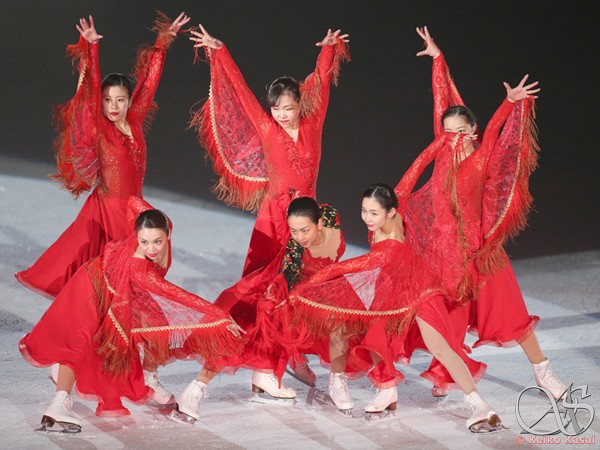
The last program before the finale was IT, the masterpiece everyone should remember because of Mao's soulful performance in the free skating at the Sochi Olympics: Piano Concerto No.2 by Rachmaninov (choreographed by Tatiana Tarasova). Mao wore the same costume she had in Moscow. Her performance was inspiring and made me (and maybe most of the audience, too) tear up. We were reminded not only of her performance in Sochi, but also of her skating career, a feeling which remained deep in our hearts and have kept giving hope to many even now. But it wasn't just her, I must not forget the others who skated with her. Sei, who landed the triple Lutz-triple toe, was very graceful, Ernesto was elegant, Seiya was very expressive, and Takahito was the superstar. At the end of the show Mao performed her enthusiastic step sequence and it made the audience excited more than anything; loud, well deserved cheering!
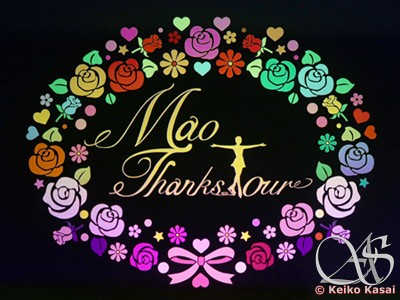 In the finale, the music Wind Beneath My Wings played to represent Mao's feeling for this tour: positive, bright and appreciative. A projection of lots of flowers brought beauty and happy feelings to the venue. Mao said each member of the tour had their own flower and color and that it was teamwork putting them all together to become the show. She also added that the meaning of the bouquet was one of thanks. The flowers were used as the tour logo as well and conveyed the spirit of the tour. Back to the finale, the skaters entered the ice one by one including Mao herself. All of them were fantastic, but Mao impressed me the most with a stunning spin, a truly special moment. After the performance was over, Mao and all the other skaters took several bows while the audience gave them long applauds and cheers. There was a special atmosphere and sense of satisfaction between the performers, who had handed out great entertainment, and the audience, who definitely received it.
In the finale, the music Wind Beneath My Wings played to represent Mao's feeling for this tour: positive, bright and appreciative. A projection of lots of flowers brought beauty and happy feelings to the venue. Mao said each member of the tour had their own flower and color and that it was teamwork putting them all together to become the show. She also added that the meaning of the bouquet was one of thanks. The flowers were used as the tour logo as well and conveyed the spirit of the tour. Back to the finale, the skaters entered the ice one by one including Mao herself. All of them were fantastic, but Mao impressed me the most with a stunning spin, a truly special moment. After the performance was over, Mao and all the other skaters took several bows while the audience gave them long applauds and cheers. There was a special atmosphere and sense of satisfaction between the performers, who had handed out great entertainment, and the audience, who definitely received it.
Mao's Thanks Tour is a one and only. I was totally involved and enchanted the entire time. As Mao mentions in the interview below, she is willing to do an overseas tour if someone invites her. So if you are interested in this tour, take action for it!
Mao is one of a few select people as a skater, and I also found her to be as wonderful a human being through this show. Thankfully, I was able to make short interviews with both Mao and Takahito, so I hope you can get a glimpse of their wonderful personalities through their answers. Our talks were conducted between the shows, and because of time being short and the stress they were under, it's understandable they needed some time to relax too. But a big thanks to them for taking the time!
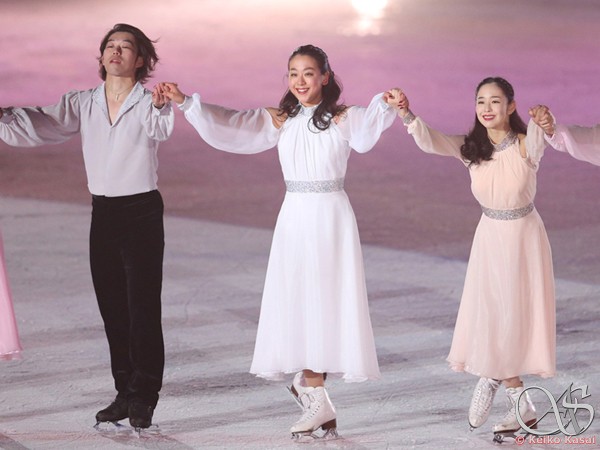
Mao Asada
This is your third year of the Thanks Tour. How do you feel about it now?
In the first year, I put everything together from scratch, and I knew nothing about creating a show, but that year passed by before I knew it. Since I never dreamed I would continue for a second year, I was very happy and made several adjustments to the show because I had gotten used to the programs. And now it's my third and last year of this tour, and I am skating in the show relishing the whole experience.
Is there a particular concept for the third year? 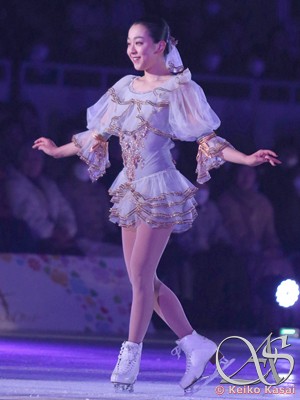
Well, we didn't change the order of the music, but we changed some costumes and the compositions a little. But everything is improving day by day.
Aren't you going to continue this tour, maybe for a fourth year? And what about doing overseas shows?
No, we will not do a fourth year. However, we would like to go to Mongolia to perform because one of our skaters, Gansukh Maral Erdene, comes from there; we are in the process of scheduling. As for other overseas performance, we will willingly consider it if there are offers.
I watched a video of you tap dancing with hearing-impaired children and encouraging children in the area affected by the earth quake. It seems charity work is close to your heart, do you have any plans for it?
I would like to actively work on what I can do. (From her manager: It's been three years since Mao started activities to support para-athletes.) And as we have many earthquakes in Japan, I'd like to go to the affected areas and meet people there. I'd be happy if I could give them some energy.
Will all the skaters in this tour scatter when the show is done?
I started this tour because I wanted to show my gratitude to the people who have supported me through my skating. But now, I am deeply grateful to all the skaters involved in this show. I want to show my gratitude to all until the end. I think everyone in this show will be off to a new start and take their own path, but I'll be happy if they feel they have gained something from participating in this show; I hope they are happy they joined me here.
Takahito Mura
How do you feel about this show? And how is it different from skating in other shows?
Well, in most other shows, a guest skater will skate about 3 or 4 times; the opening, the finale, and his own program or programs. But here I keep skating from the beginning to the end; that gives you a clue. And I have been involved since the launch, so this is pretty special compared to other shows. Not only do I get to pursue my own decent performances, but I also have to think about the show's appeal, which depends on whether we, all ten skaters together, can deliver something worthwhile for the audience to turn up for. So I care about and listen to the younger skaters to make the show better. 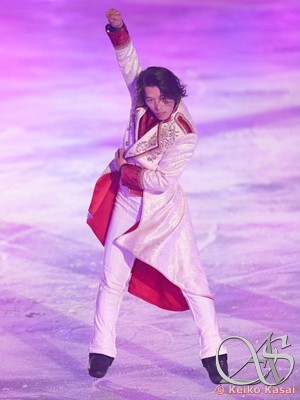 We are now in the third year, and I realize that I need to listen to the young skaters and talk with them about how we can improve. We recently changed the ladies part and I felt it made the show better. So the men were inspired by it and became more aware of their performances, so they got much better, for example in the Rachmaninov piece.
We are now in the third year, and I realize that I need to listen to the young skaters and talk with them about how we can improve. We recently changed the ladies part and I felt it made the show better. So the men were inspired by it and became more aware of their performances, so they got much better, for example in the Rachmaninov piece.
In other words, you have a certain role here in the Thanks Tour, a role as big brother to the other skaters?
Well, I don't know... (The manager's voice from a distance: "Yes, he certainly does. It must be hard for him to say 'Yes, I am a big brother to them'". And Mao also cut into our conversation and said, "He's like our father! He's our go-to person; a person who can support us just by being there. Well, we are about the same age; however, we count on him! Sorry for interrupting".).
Where do you usually practice?
We use Ageo, or sometimes outdoor rinks, like the Futako-Tamagawa, Midtown or some other rinks.
Do you teach now?
No. I don't work as a coach, yet. I sometimes help my father (Takashi Mura), but I don't do any specific coaching.
Do you want to become a coach?
Well, I'm interested in coaching so I should study it. But even if I wanted to coach now, it would be impossible given the current situation. I leave the rink every weekend because of shows, so it would be irresponsible to have a student. But I think I will focus on coaching in the future.
You have many male fans too, don't you?
Sort of, I guess. I skated in a game-themed show, which had many male fans. They grew fond of me and came to the Thanks Tour to watch me skate. I am very grateful for any men interested in figure skating, which as you know even at competitions has 90% women in the audience. But some of these men wanted to skate themselves, 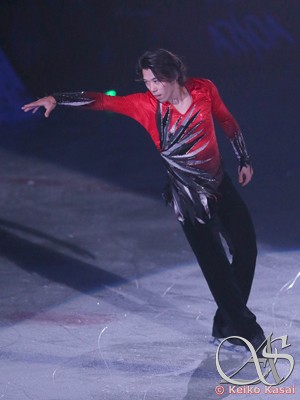 and some have actually started! It makes me happy as I feel I've somehow been able to contribute to figure skating. We have started some events mainly for men, and we already planned one in Okayama in April and have already received many applications including many men.
and some have actually started! It makes me happy as I feel I've somehow been able to contribute to figure skating. We have started some events mainly for men, and we already planned one in Okayama in April and have already received many applications including many men.
Is there anything you, as a professional skater, would like to say to young skaters?
I can't think of anything because the young skaters today have far better technique than we learned. My only advice is to establish your own self through your skating career. Find out who you are and try to express it through your performance. I recognized it only at the end of my eligible career, but I think it will make a big difference in your performance if you are aware.
Some professional skaters are much more expressive after their retirement from competitions, as you seem to be. Why is that, and what can the younger generation skaters learn from it?
For me it was choosing different types of music than I used to skate to. In the Thanks Tour, I've had to take on music I never would have considered, and I watched Mao's performances, which I didn't do before. I thought the most important element for a professional skater was how much he/she could involve the audience, which is very different from a competition with judges. I could not have recognized it when I was a competitive skater. So I think it would be better to take on something new which you have not ever thought of. You might reevaluate your own style and find a new self.



